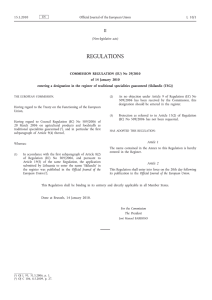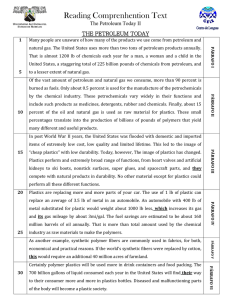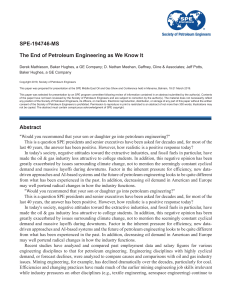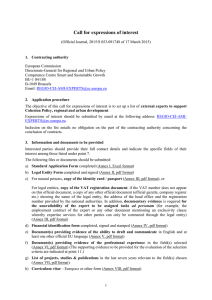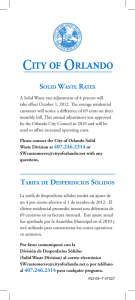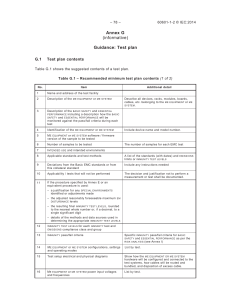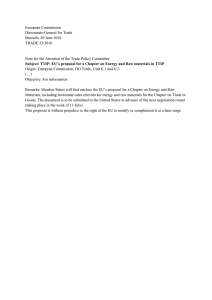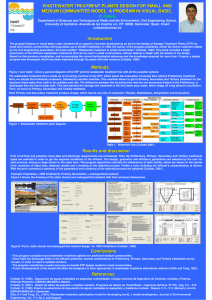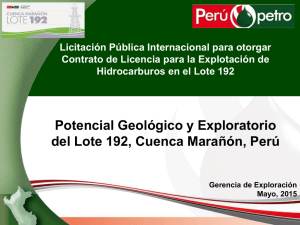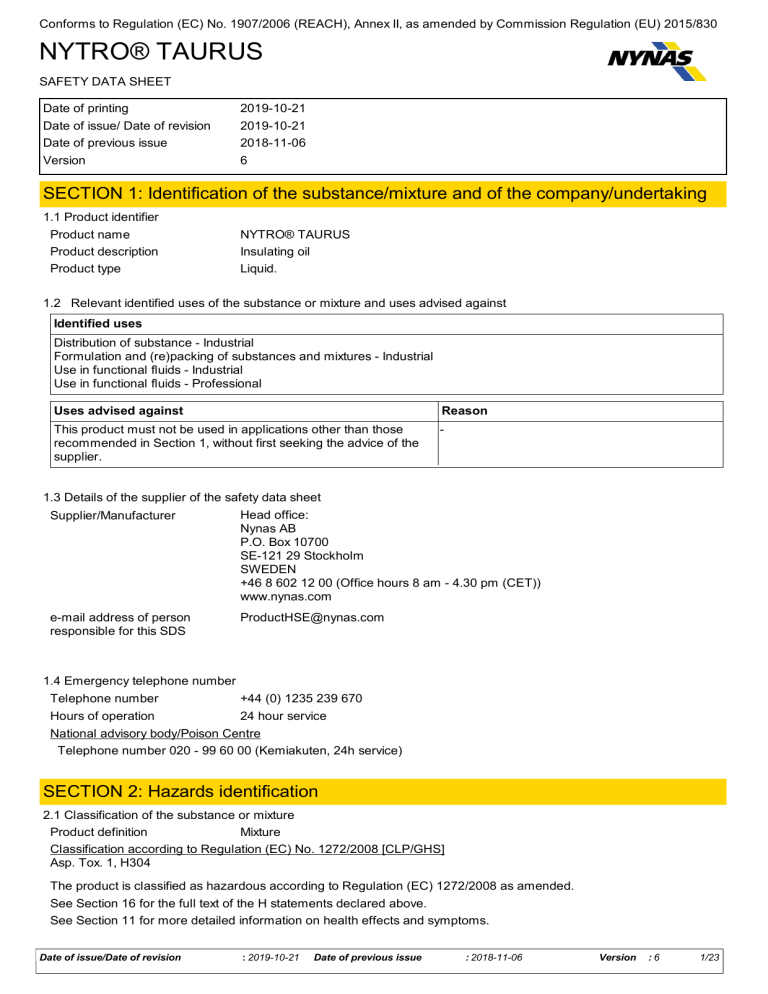
Conforms to Regulation (EC) No. 1907/2006 (REACH), Annex II, as amended by Commission Regulation (EU) 2015/830 NYTRO® TAURUS SAFETY DATA SHEET Date of printing 2019-10-21 Date of issue/ Date of revision Date of previous issue 2019-10-21 2018-11-06 Version 6 SECTION 1: Identification of the substance/mixture and of the company/undertaking 1.1 Product identifier Product name Product description Product type NYTRO® TAURUS Insulating oil Liquid. 1.2 Relevant identified uses of the substance or mixture and uses advised against Identified uses Distribution of substance - Industrial Formulation and (re)packing of substances and mixtures - Industrial Use in functional fluids - Industrial Use in functional fluids - Professional Uses advised against Reason This product must not be used in applications other than those recommended in Section 1, without first seeking the advice of the supplier. - 1.3 Details of the supplier of the safety data sheet Supplier/Manufacturer Head office: Nynas AB P.O. Box 10700 SE-121 29 Stockholm SWEDEN +46 8 602 12 00 (Office hours 8 am - 4.30 pm (CET)) www.nynas.com e-mail address of person responsible for this SDS ProductHSE@nynas.com 1.4 Emergency telephone number Telephone number Hours of operation +44 (0) 1235 239 670 24 hour service National advisory body/Poison Centre Telephone number 020 - 99 60 00 (Kemiakuten, 24h service) SECTION 2: Hazards identification 2.1 Classification of the substance or mixture Product definition Mixture Classification according to Regulation (EC) No. 1272/2008 [CLP/GHS] Asp. Tox. 1, H304 The product is classified as hazardous according to Regulation (EC) 1272/2008 as amended. See Section 16 for the full text of the H statements declared above. See Section 11 for more detailed information on health effects and symptoms. Date of issue/Date of revision : 2019-10-21 Date of previous issue : 2018-11-06 Version :6 1/23 Conforms to Regulation (EC) No. 1907/2006 (REACH), Annex II NYTRO® TAURUS SECTION 2: Hazards identification 2.2 Label elements Hazard pictograms Signal word Hazard statements Precautionary statements Prevention Response Storage Disposal Supplemental label elements Annex XVII - Restrictions on the manufacture, placing on the market and use of certain dangerous substances, mixtures and articles 2.3 Other hazards Product meets the criteria for PBT or vPvB according to Regulation (EC) No. 1907/2006, Annex XIII Other hazards which do not result in classification Danger H304 - May be fatal if swallowed and enters airways. Not applicable. P301 + P310 + P331 - IF SWALLOWED: Immediately call a POISON CENTER or physician. Do NOT induce vomiting. P405 - Store locked up. P501 - Dispose of contents and container in accordance with all local, regional, national and international regulations. Not applicable. Not applicable. This mixture does not contain any substances that are assessed to be a PBT or a vPvB. Prolonged or repeated contact may dry skin and cause irritation. SECTION 3: Composition/information on ingredients 3.2 Mixtures Mixture Product/ingredient name Distillates (petroleum), hydrotreated light naphthenic Distillates (petroleum), hydrotreated light paraffinic Lubricating oils (petroleum), C20-50, hydrotreated neutral oilbased Lubricating oils (petroleum), C15-30, hydrotreated neutral oilbased Distillates (petroleum), solventrefined heavy naphthenic Date of issue/Date of revision Identifiers REACH #: 01-2119480375-34 EC: 265-156-6 CAS: 64742-53-6 Index: 649-466-00-2 REACH #: 01-2119487077-29 EC: 265-158-7 CAS: 64742-55-8 REACH #: 01-2119474889-13 EC: 276-738-4 CAS: 72623-87-1 Index: 649-483-00-5 REACH #: 01-2119474878-16 EC: 276-737-9 CAS: 72623-86-0 Index: 649-482-00-X REACH #: 01-2119483621-38 : 2019-10-21 Date of previous issue % Regulation (EC) No. 1272/2008 [CLP] Type 60 - 80 Asp. Tox. 1, H304 [1] [2] 20 - 40 Asp. Tox. 1, H304 [1] [2] 0 - 30 Asp. Tox. 1, H304 [1] [2] 0 - 30 Asp. Tox. 1, H304 [1] [2] 0-5 Not classified. [2] : 2018-11-06 Version :6 2/23 Conforms to Regulation (EC) No. 1907/2006 (REACH), Annex II NYTRO® TAURUS SECTION 3: Composition/information on ingredients EC: 265-097-6 CAS: 64741-96-4 Index: 649-457-00-3 See Section 16 for the full text of the H statements declared above. Regulation (EC) No. 1272/2008 [CLP] Annex VI Nota L applies to the base oil(s) in this product. Nota L - The classification as a carcinogen need not apply if it can be shown that the substance contains less than 3 % DMSO extract as measured by IP 346. There are no additional ingredients present which, within the current knowledge of the supplier and in the concentrations applicable, are classified as hazardous to health or the environment, are PBTs, vPvBs or Substances of equivalent concern, or have been assigned a workplace exposure limit and hence require reporting in this section. Type [1] Substance classified with a health or environmental hazard [2] Substance with a workplace exposure limit [3] Substance meets the criteria for PBT according to Regulation (EC) No. 1907/2006, Annex XIII [4] Substance meets the criteria for vPvB according to Regulation (EC) No. 1907/2006, Annex XIII [5] Substance of equivalent concern [6] Additional disclosure due to company policy Occupational exposure limits, if available, are listed in Section 8. SECTION 4: First aid measures 4.1 Description of first aid measures Eye contact Rinse cautiously with water for several minutes. Remove contact lenses, if present and easy to do. Continue rinsing. If irritation, blurred vision or swelling occurs and persists, obtain medical advice from a specialist. Inhalation If breathing is difficult, remove victim to fresh air and keep at rest in a position comfortable for breathing. If casualty is unconscious and: If not breathing, if breathing is irregular or if respiratory arrest occurs, provide artificial respiration or oxygen by trained personnel. Get medical attention if adverse health effects persist or are severe. Maintain an open airway. Skin contact Wash with soap and water. Remove contaminated clothing and shoes. Handle with care and dispose of in a safe manner. Seek medical attention if skin irritation, swelling or redness develops and persists. Ingestion Protection of first-aiders Accidental high pressure injection through the skin requires immediate medical attention. Do not wait for symptoms to develop. Always assume that aspiration has occurred. Do not induce vomiting. Can enter lungs and cause damage. If vomiting occurs, the head should be kept low so that vomit does not enter the lungs. Seek professional medical attention or send the casualty to a hospital. Do not wait for symptoms to develop. Never give anything by mouth to an unconscious person. If unconscious, place in recovery position and get medical attention immediately. Maintain an open airway. Loosen tight clothing such as a collar, tie, belt or waistband. No action shall be taken involving any personal risk or without suitable training. It may be dangerous to the person providing aid to give mouth-to-mouth resuscitation. Before attempting to rescue casualties, isolate area from all potential sources of ignition including disconnecting electrical supply. Ensure adequate ventilation and check that a safe, breathable atmosphere is present before entry into confined spaces. 4.2 Most important symptoms and effects, both acute and delayed Over-exposure signs/symptoms Eye contact Date of issue/Date of revision Slight irritant : 2019-10-21 Date of previous issue : 2018-11-06 Version :6 3/23 Conforms to Regulation (EC) No. 1907/2006 (REACH), Annex II NYTRO® TAURUS SECTION 4: First aid measures Inhalation Inhalation of oil mist or vapours at elevated temperatures may cause respiratory irritation. Skin contact Adverse symptoms may include the following: irritation dryness cracking Adverse symptoms may include the following: Nausea or vomiting. diarrhoea Ingestion 4.3 Indication of any immediate medical attention and special treatment needed Notes to physician Due to low viscosity there is a risk of aspiration if the product enters the lungs. Treat symptomatically. Specific treatments Always assume that aspiration has occurred. SECTION 5: Firefighting measures 5.1 Extinguishing media Suitable extinguishing media Use dry chemical, CO₂, water spray (fog) or foam. Unsuitable extinguishing media Do not use direct water jets on the burning product; they could cause splattering and spread the fire. Simultaneous use of foam and water on the same surface is to be avoided as water destroys the foam. 5.2 Special hazards arising from the substance or mixture Hazards from the substance In a fire or if heated, a pressure increase will occur and the container may burst. This or mixture substance will float and can be reignited on surface water. Hazardous combustion products 5.3 Advice for firefighters Special precautions for firefighters Special protective equipment for fire-fighters Incomplete combustion is likely to give rise to a complex mixture of airborne solid and liquid particulates, gases, including carbon monoxide, H2S, SOx (sulfur oxides) or sulfuric acid and unidentified organic and inorganic compounds. Promptly isolate the scene by removing all persons from the vicinity of the incident if there is a fire. No action shall be taken involving any personal risk or without suitable training. Fire-fighters should wear appropriate protective equipment and self-contained breathing apparatus (SCBA) with a full face-piece operated in positive pressure mode. Clothing for fire-fighters (including helmets, protective boots and gloves) conforming to European standard EN 469 will provide a basic level of protection for chemical incidents. SECTION 6: Accidental release measures 6.1 Personal precautions, protective equipment and emergency procedures For non-emergency Avoid breathing vapour or mist. Keep non-involved personnel away from the area of personnel spillage. Alert emergency personnel. Except in case of small spillages, the feasibility of any actions should always be assessed and advised, if possible, by a trained, competent person in charge of managing the emergency. Stop leak if safe to do so. Avoid direct contact with the product. Stay upwind/keep distance from source. In case of large spillages, alert occupants in downwind areas. Eliminate all ignition sources if safe to do so. Spillages of limited amounts of product, especially in the open air when vapours will be usually quickly dispersed, are dynamic situations, which will presumably limit the exposure to dangerous concentrations. Note : recommended measures are based on the most likely spillage scenarios for this material; however, local conditions (wind, air temperature, wave/current direction and speed) may significantly influence the choice of appropriate actions. For this Date of issue/Date of revision : 2019-10-21 Date of previous issue : 2018-11-06 Version :6 4/23 Conforms to Regulation (EC) No. 1907/2006 (REACH), Annex II NYTRO® TAURUS SECTION 6: Accidental release measures For emergency responders reason, local experts should be consulted when necessary. Local regulations may also prescribe or limit actions to be taken. Small spillages: normal antistatic working clothes are usually adequate. Large spillages: full body suit of chemically resistant and thermal resistant material should be used. Work gloves providing adequate chemical resistance, specifically to aromatic hydrocarbons. Note : gloves made of PVA are not water-resistant, and are not suitable for emergency use. Safety helmet, antistatic non-skid safety shoes or boots. Goggles and /or face shield, if splashes or contact with eyes is possible or anticipated. Respiratory protection : A half or full-face respirator with filter(s) for organic vapours (and when applicable for H2S) a Self Contained Breathing Apparatus (SCBA) can be used according to the extent of spill and predictable amount of exposure. If the situation cannot be completely assessed, or if an oxygen deficiency is possible, only SCBA’s should be used. 6.2 Environmental precautions Prevent product from entering sewers, rivers or other bodies of water. If necessary dike the product with dry earth, sand or similar non-combustible materials. In case of soil contamination, remove contaminated soil and treat in accordance with local regulations. In case of small spillages in closed waters (i.e. ports), contain product with floating barriers or other equipment. Collect spilled product by absorbing with specific floating absorbents. If possible, large spillages in open waters should be contained with floating barriers or other mechanical means. If this is not possible, control the spreading of the spillage, and collect the product by skimming or other suitable mechanical means. The use of dispersants should be advised by an expert, and, if required, approved by local authorities. 6.3 Methods and material for containment and cleaning up Small spill Stop leak if without risk. Absorb spilled product with suitable non-combustible materials. Large spill Large spillages may be cautiously covered with foam, if available, to limit vapour cloud formation. Do not use water jet. When inside buildings or confined spaces, ensure adequate ventilation. Transfer collected product and other contaminated materials to suitable containers for recovery or safe disposal. Approach the release from upwind. Contaminated absorbent material may pose the same hazard as the spilt product. 6.4 Reference to other sections See Section 1 for emergency contact information. See Section 8 for information on appropriate personal protective equipment. See Section 13 for additional waste treatment information. SECTION 7: Handling and storage The information in this section contains generic advice and guidance. The list of Identified Uses in Section 1 should be consulted for any available use-specific information provided in the Exposure Scenario(s). General information Obtain special instructions before use. Keep away from heat/sparks/open flames/hot surfaces. - No smoking. Use and store only outdoors or in a well-ventilated area. Hazard of slipping on spilt product. Avoid release to the environment. 7.1 Precautions for safe handling Protective measures Do not ingest. Do not breathe dust/fume/gas/mist/vapours/spray. Avoid contact with eyes, skin and clothing. Keep in the original container or an approved alternative made from a compatible material, kept tightly closed when not in use. Prevent the risk of slipping. Take precautionary measures against static discharge. Avoid splash filling of bulk volumes when handling hot liquid product. Empty containers retain product residue and can be hazardous. Date of issue/Date of revision : 2019-10-21 Date of previous issue : 2018-11-06 Version :6 5/23 Conforms to Regulation (EC) No. 1907/2006 (REACH), Annex II NYTRO® TAURUS SECTION 7: Handling and storage Nota : See Section 8 for information on appropriate personal protective equipment. See section 13 for waste disposal information. Advice on general occupational hygiene Ensure that proper housekeeping measures are in place. Contaminated materials should not be allowed to accumulate in the workplaces and should never be kept inside the pockets. Eating, drinking and smoking should be prohibited in areas where this material is handled, stored and processed. Wash hands thoroughly after handling. Change contaminated clothes at the end of working shift. See also Section 8 for additional information on hygiene measures. 7.2 Conditions for safe storage, including any incompatibilities Storage area layout, tank design, equipment and operating procedures must comply with the relevant regional, national or local legislation. Storage installations should be designed with adequate bunds in case of leaks or spills. Cleaning, inspection and maintenance of internal structure of storage tanks must be done only by properly equipped and qualified personnel as defined by national, local or company regulations. Store separately from oxidising agents. Recommended materials for containers, or container linings use mild steel, stainless steel. Not suitable : Some synthetic materials may be unsuitable for containers or container linings depending on the material specification and intended use. Compatibility should be checked with the manufacturer. Keep only in the original container or in a suitable container for this kind of product. Keep container tightly closed and sealed until ready for use. Do not store in unlabelled containers. Containers that have been opened must be carefully resealed and kept upright to prevent leakage. Empty containers may contain harmful, flammable/combustible or explosive residue or vapours. Do not cut, grind, drill, weld, reuse or dispose of containers unless adequate precautions are taken against these hazards. Store locked up. Protect from sunlight. 7.3 Specific end use(s) Recommendations Industrial sector specific solutions Not available. Not available. SECTION 8: Exposure controls/personal protection The information in this section contains generic advice and guidance. The list of Identified Uses in Section 1 should be consulted for any available use-specific information provided in the Exposure Scenario(s). 8.1 Control parameters Occupational exposure limits Product/ingredient name Exposure limit values Distillates (petroleum), hydrotreated light naphthenic Work environment authority Regulation 2018:1 (Sweden, 2/2018). TWA: 1 mg/m³ 8 hours. Form: mist and fume STEL: 3 mg/m³ 15 minutes. Form: mist and fume Work environment authority Regulation 2018:1 (Sweden, 2/2018). TWA: 1 mg/m³ 8 hours. Form: mist and fume STEL: 3 mg/m³ 15 minutes. Form: mist and fume Work environment authority Regulation 2018:1 (Sweden, 2/2018). TWA: 1 mg/m³ 8 hours. Form: mist and fume STEL: 3 mg/m³ 15 minutes. Form: mist and fume Work environment authority Regulation 2018:1 (Sweden, 2/2018). Distillates (petroleum), hydrotreated light paraffinic Lubricating oils (petroleum), C20-50, hydrotreated neutral oil-based Lubricating oils (petroleum), C15-30, hydrotreated neutral oil-based Date of issue/Date of revision : 2019-10-21 Date of previous issue : 2018-11-06 Version :6 6/23 Conforms to Regulation (EC) No. 1907/2006 (REACH), Annex II NYTRO® TAURUS SECTION 8: Exposure controls/personal protection Distillates (petroleum), solvent-refined heavy naphthenic Oil mist Recommended monitoring procedures TWA: 1 mg/m³ 8 hours. Form: mist and fume STEL: 3 mg/m³ 15 minutes. Form: mist and fume Work environment authority Regulation 2018:1 (Sweden, 2/2018). TWA: 1 mg/m³ 8 hours. Form: mist and fume STEL: 3 mg/m³ 15 minutes. Form: mist and fume [Air contaminant] Work environment authority Regulation 2018:1 (Sweden, 2/2018). TWA: 1 mg/m³ 8 hours. Form: mist and fume STEL: 3 mg/m³ 15 minutes. Form: mist and fume If this product contains ingredients with exposure limits, personal, workplace atmosphere or biological monitoring may be required to determine the effectiveness of the ventilation or other control measures and/or the necessity to use respiratory protective equipment. Reference should be made to monitoring standards, such as the following: European Standard EN 689 (Workplace atmospheres - Guidance for the assessment of exposure by inhalation to chemical agents for comparison with limit values and measurement strategy) European Standard EN 14042 (Workplace atmospheres - Guide for the application and use of procedures for the assessment of exposure to chemical and biological agents) European Standard EN 482 (Workplace atmospheres - General requirements for the performance of procedures for the measurement of chemical agents) Reference to national guidance documents for methods for the determination of hazardous substances will also be required. DNELs/DMELs Product/ingredient name Type Exposure Distillate (petroleum), hydrotreated light naphthenic Distillates (petroleum), hydrotreated light paraffinic Lubricating oils (petroleum), C20-50, hydrotreated neutral oil-based Lubricating oils (petroleum), C15-30, hydrotreated neutral oil-based DNEL Long term Inhalation DNEL Long term Inhalation DNEL Long term Inhalation DNEL Long term Inhalation Value Population Effects 5,58 mg/m³ Workers Local 5,58 mg/m³ Workers Local 5,58 mg/m³ Workers Local 5,58 mg/m³ Workers Local PNECs No PNECs available PNEC Summary Hydrocarbon Block Method (Petrorisk) 8.2 Exposure controls Appropriate engineering controls Mechanical ventilation and local exhaust will reduce exposure via the air. Use oil resistant material in construction of handling equipment. Store under recommended conditions and if heated, temperature control equipment should be used to avoid overheating. Individual protection measures Hygiene measures Eye/face protection Wash hands, forearms and face thoroughly after handling chemical products, before eating, smoking and using the lavatory and at the end of the working period. Ensure that eyewash stations and safety showers are close to the workstation location. Wash contaminated clothing before reuse. Recommended: Safety glasses with side shields. Skin protection Hand protection 4 - 8 hours (breakthrough time): nitrile rubber Body protection Other skin protection Date of issue/Date of revision Wear protective clothing if there is a risk of skin contact. Change contaminated clothes at the end of working shift. Appropriate footwear and any additional skin protection measures should be selected based on the task being performed and the risks involved and should be approved by a specialist before handling this product. : 2019-10-21 Date of previous issue : 2018-11-06 Version :6 7/23 Conforms to Regulation (EC) No. 1907/2006 (REACH), Annex II NYTRO® TAURUS SECTION 8: Exposure controls/personal protection Respiratory protection Environmental exposure controls Respirator selection must be based on known or anticipated exposure levels, the hazards of the product and the safe working limits of the selected respirator. Use a properly fitted, particulate filter respirator complying with an approved standard if a risk assessment indicates this is necessary. Emissions from ventilation or work process equipment should be checked to ensure they comply with the requirements of environmental protection legislation. In some cases, fume scrubbers, filters or engineering modifications to the process equipment will be necessary to reduce emissions to acceptable levels. SECTION 9: Physical and chemical properties 9.1 Information on basic physical and chemical properties Appearance Physical state Colour Odour Odour threshold pH Melting point/freezing point Initial boiling point and boiling range Liquid. Light yellow Odourless/Light petroleum. Not available. Not applicable. -48°C Not available. Flash point Closed cup: >140°C [Pensky-Martens.] Evaporation rate Flammability (solid, gas) Upper/lower flammability or explosive limits Not available. Not available. Not available. Vapour pressure (Calculated) Density Not available. 0,87 g/cm³ [15°C] Solubility(ies) Partition coefficient: n-octanol/ water Insoluble in water. Not available. Auto-ignition temperature >200°C Decomposition temperature Viscosity Explosive properties Oxidising properties DMSO extractable compounds for base oil substance(s) according to IP346 280°C Kinematic (40°C): 0,1 cm 2/s (10 cSt) Not available. Not available. < 3% SECTION 10: Stability and reactivity 10.1 Reactivity No specific test data related to reactivity available for this product or its ingredients. 10.2 Chemical stability Stable under normal conditions. 10.3 Possibility of hazardous reactions Under normal conditions of storage and use, hazardous reactions will not occur. 10.4 Conditions to avoid Keep away from extreme heat and oxidizing agents. Take precautionary measures against static discharge. 10.5 Incompatible materials Oxidizing agent Date of issue/Date of revision : 2019-10-21 Date of previous issue : 2018-11-06 Version :6 8/23 Conforms to Regulation (EC) No. 1907/2006 (REACH), Annex II NYTRO® TAURUS SECTION 10: Stability and reactivity 10.6 Hazardous decomposition products Incomplete combustion is likely to give rise to a complex mixture of airborne solid and liquid particulates, gases, including carbon monoxide, H2S, SOx (sulfur oxides) or sulfuric acid and unidentified organic and inorganic compounds. SECTION 11: Toxicological information 11.1 Information on toxicological effects Acute toxicity Product/ingredient name Result Species Dose Exposure Remarks Distillates (petroleum), hydrotreated light naphthenic LC50 Inhalation Dusts and mists Rat >5,53 mg/l 4 hours LD50 Dermal Rabbit >5000 mg/kg - LD50 Oral Rat >5000 mg/kg - LC50 Inhalation Dusts and mists Rat >5,53 mg/l LD50 Dermal Rabbit >5000 mg/kg - LD50 Oral Rat >5000 mg/kg - LC50 Inhalation Dusts and mists Rat - Male, >5,53 mg/l Female LD50 Dermal Rabbit >5000 mg/kg - LD50 Oral Rat >5000 mg/kg - LC50 Inhalation Dusts and mists Rat - Male, >5,53 mg/l Female LD50 Dermal Rabbit >5000 mg/kg - LD50 Oral Rat >5000 mg/kg - Distillates (petroleum), hydrotreated light paraffinic Lubricating oils (petroleum), C20-50, hydrotreated neutral oilbased Lubricating oils (petroleum), C15-30, hydrotreated neutral oilbased Conclusion/Summary Acute toxicity estimates 4 hours 4 hours 4 hours EMBSI 1988 (similar material) API 1982 (similar material) API 1982(similar material) EMBSI 1988 (similar material) API 1982 (similar material) API 1982(similar material) EMBSI 1988 (similar material) API 1982 (similar material) API 1982 (similar material) EMBSI 1988 (similar material) API 1982 (similar material) API 1982(similar material) Based on available data, the classification criteria are not met. N/A Irritation/Corrosion Product/ingredient name Result Species Score Observation Remarks Distillates (petroleum), hydrotreated light naphthenic Skin - Non-irritant to skin. Rabbit 0 to 1 24 to 72 hours API 1982(similar material) Eyes - Non-irritating to the eyes. Skin - Non-irritant to skin. Rabbit 0 to 0,11 Rabbit 0 to 1 24 to 72 hours 24 to 72 hours API 1982(similar material) API 1982(similar material) Eyes - Non-irritating to the eyes. Eyes - Non-irritating to the eyes. Rabbit 0 to 0,11 Rabbit 0 to 0,11 24 to 72 hours 24 to 72 hours API 1982(similar material) API 1982(similar material) Distillates (petroleum), hydrotreated light paraffinic Lubricating oils (petroleum), C20-50, hydrotreated neutral oilDate of issue/Date of revision : 2019-10-21 Date of previous issue : 2018-11-06 Version :6 9/23 Conforms to Regulation (EC) No. 1907/2006 (REACH), Annex II NYTRO® TAURUS SECTION 11: Toxicological information based Lubricating oils (petroleum), C15-30, hydrotreated neutral oilbased Skin - Non-irritant to skin. Rabbit 0 to 1 24 to 72 hours API 1982 (similar material) Eyes - Non-irritating to the eyes. Rabbit 0 to 0,11 24 to 72 hours API 1982(similar material) Skin Based on available data, the classification criteria are not met. Eyes Respiratory Based on available data, the classification criteria are not met. Based on available data, the classification criteria are not met. Sensitisation Product/ingredient name Route of exposure Species Result Remarks Distillates (petroleum), hydrotreated light naphthenic Distillates (petroleum), hydrotreated light paraffinic Lubricating oils (petroleum), C20-50, hydrotreated neutral oilbased Lubricating oils (petroleum), C15-30, hydrotreated neutral oilbased skin Guinea pig Not sensitizing API 1982(similar material) skin Guinea pig Not sensitizing API 1982(similar material) skin Guinea pig Not sensitizing API 1982(similar material) skin Guinea pig Not sensitizing UBTL 1984j,k,l (similar material) Skin Respiratory Mutagenicity Conclusion/Summary Carcinogenicity Conclusion/Summary Based on available data, the classification criteria are not met. Based on available data, the classification criteria are not met. Based on available data, the classification criteria are not met. The base oil(s) in this product is based on an severely hydrotreated distillate. The product should not be regarded as a carcinogen. Reproductive toxicity Conclusion/Summary Teratogenicity Based on available data, the classification criteria are not met. Conclusion/Summary Aspiration hazard Based on available data, the classification criteria are not met. Product/ingredient name Result Distillates (petroleum), hydrotreated light naphthenic Distillates (petroleum), hydrotreated light paraffinic Lubricating oils (petroleum), C20-50, hydrotreated neutral oilbased Lubricating oils (petroleum), C15-30, hydrotreated neutral oilbased ASPIRATION HAZARD - Category 1 ASPIRATION HAZARD - Category 1 ASPIRATION HAZARD - Category 1 ASPIRATION HAZARD - Category 1 Potential chronic health effects Date of issue/Date of revision : 2019-10-21 Date of previous issue : 2018-11-06 Version :6 10/23 Conforms to Regulation (EC) No. 1907/2006 (REACH), Annex II NYTRO® TAURUS SECTION 11: Toxicological information Product/ingredient name Result Species Dose Exposure Distillate (petroleum), hydrotreated light naphthenic Sub-chronic LOAEL Oral Rat 125 mg/kg - Sub-chronic NOAEL Dermal Sub-acute NOEL Inhalation Dusts and mists Sub-chronic LOAEL Oral Rat Rat >2000 mg/kg 220 mg/m³ Rat 125 mg/kg 6 hours; 5 days per week - Sub-chronic NOAEL Dermal Sub-acute NOEL Inhalation Dusts and mists Sub-chronic LOAEL Oral Rat Rat >2000 mg/kg 220 mg/m³ Rat 125 mg/kg Sub-chronic NOAEL Dermal Sub-acute NOEL Inhalation Dusts and mists Sub-chronic LOAEL Oral Rat Rat >2000 mg/kg 220 mg/m³ Rabbit 125 mg/kg Sub-chronic NOAEL Dermal Sub-chronic NOEL Inhalation Dusts and mists Rat Rat >2000 mg/kg 220 mg/m³ Distillates (petroleum), hydrotreated light paraffinic Lubricating oils (petroleum), C20-50, hydrotreated neutral oil-based Lubricating oils (petroleum), C15-30, hydrotreated neutral oil-based Specific hazard 6 hours; 5 days per week 6 hours; 5 days per week 6 hours; 5 days per week Aspiration hazard Aspiration means the entry of a liquid substance directly into the trachea and lower respiratory tract. Aspiration of hydrocarbon substances can result in in severe acute effects such as chemical pneumonitis, varying degree of pulmonary injury or death. This property relates to the potential for low viscosity material to spread quickly into the deep lung and cause severe pulmonary tissue damage. Classification of a hydrocarbon substance for aspiration hazard is made on the basis of reliable human evidence or on the basis of physical properties. SECTION 12: Ecological information 12.1 Toxicity Product/ingredient name Result Species Exposure Distillates (petroleum), hydrotreated light naphthenic Acute EL50 >10000 mg/l Daphnia 48 hours Acute LL50 >100 mg/l Acute NOEL >100 mg/l Chronic NOEL 10 mg/l Fresh water Acute EL50 >10000 mg/l Fish Algae Daphnia Daphnia 96 hours 72 hours 21 days 48 hours Acute LL50 >100 mg/l Acute NOEL >100 mg/l Chronic NOEL 10 mg/l Fresh water Acute LL50 >10000 mg/l Fish Algae Daphnia Aquatic invertebrates. 96 hours 72 hours 21 days 96 hours Acute LL50 >100 mg/l Acute NOEL >100 mg/l Chronic NOEL 10 mg/l Acute EL50 >10000 mg/l Fish Algae Daphnia Daphnia 96 hours 72 hours 21 days 48 hours Acute LL50 >100 mg/l Fish Acute NOEL >100 mg/l Algae Chronic NOEL 10 mg/l Fresh water Daphnia 96 hours 72 hours 21 days Distillates (petroleum), hydrotreated light paraffinic Lubricating oils (petroleum), C20-50, hydrotreated neutral oil-based Lubricating oils (petroleum), C15-30, hydrotreated neutral oil-based Conclusion/Summary Date of issue/Date of revision Based on available data, the classification criteria are not met. : 2019-10-21 Date of previous issue : 2018-11-06 Version :6 11/23 Conforms to Regulation (EC) No. 1907/2006 (REACH), Annex II NYTRO® TAURUS SECTION 12: Ecological information 12.2 Persistence and degradability Product/ingredient name Aquatic half-life Photolysis Biodegradability Distillates (petroleum), hydrotreated light naphthenic Distillates (petroleum), hydrotreated light paraffinic Lubricating oils (petroleum), C20-50, hydrotreated neutral oil-based Lubricating oils (petroleum), C15-30, hydrotreated neutral oil-based - - Inherent - - Inherent - - Inherent - - Inherent Conclusion/Summary Inherently biodegradable. 12.3 Bioaccumulative potential Product/ingredient name LogPow BCF Potential Distillates (petroleum), hydrotreated light naphthenic Distillates (petroleum), hydrotreated light paraffinic Lubricating oils (petroleum), C20-50, hydrotreated neutral oil-based Lubricating oils (petroleum), C15-30, hydrotreated neutral oil-based 2 to 6 <500 low 2 to 6 <500 low 2 to 6 <500 low 2 to 6 <500 low Conclusion/Summary The product has a potential to bioaccumulate. 12.4 Mobility in soil Mobility High mobility in soil predicted, based on log Kow > 3.0. 12.5 Results of PBT and vPvB assessment This mixture does not contain any substances that are assessed to be a PBT or a vPvB. 12.6 Other adverse effects Insoluble in water. Spills may form a film on water surfaces causing physical damage to organisms. Oxygen transfer could also be impaired. SECTION 13: Disposal considerations The information in this section contains generic advice and guidance. The list of Identified Uses in Section 1 should be consulted for any available use-specific information provided in the Exposure Scenario(s). 13.1 Waste treatment methods Product Methods of disposal Hazardous waste Where possible (e.g. in the absence of relevant contamination), recycling of used substance is feasible and recommended. This substance can be burned or incinerated, subject to national/local authorizations, relevant contamination limits, safety regulations and air quality legislation. Contaminated or waste substance (not directly recyclable): Disposal can be carried out directly, or by delivery to qualified waste handlers. National legislation may identify a specific organization, and/or prescribe composition limits and methods for recovery or disposal. Yes. European waste catalogue (EWC) Waste code Waste designation 13 03 07* mineral-based non-chlorinated insulating and heat transmission oils Date of issue/Date of revision : 2019-10-21 Date of previous issue : 2018-11-06 Version :6 12/23 Conforms to Regulation (EC) No. 1907/2006 (REACH), Annex II NYTRO® TAURUS SECTION 13: Disposal considerations Packaging Methods of disposal The generation of waste should be avoided or minimised wherever possible. Waste packaging should be recycled. Incineration or landfill should only be considered when recycling is not feasible. SECTION 14: Transport information International transport regulations ADR/RID ADN IMO/IMDG Classification ICAO/IATA Classification 14.1 UN number Not regulated. Not regulated. Not regulated. Not regulated. 14.2 UN proper shipping name - - - - 14.3 Transport hazard class(es) - - - - 14.4 Packing group - - - - 14.5 Environmental hazards No. No. No. No. 14.6 Special precautions for user Transport within user’s premises: always transport in closed containers that are upright and secure. Ensure that persons transporting the product know what to do in the event of an accident or spillage. 14.7 MARPOL Annex 1 Oils SECTION 15: Regulatory information 15.1 Safety, health and environmental regulations/legislation specific for the substance or mixture EU Regulation (EC) No. 1907/2006 (REACH) Annex XIV - List of substances subject to authorisation None of the components are listed. Substances of very high concern None of the components are listed. Annex XVII - Restrictions on Not applicable. the manufacture, placing on the market and use of certain dangerous substances, mixtures and articles Other EU regulations Industrial emissions (integrated pollution prevention and control) - Air Not listed Industrial emissions Not listed (integrated pollution prevention and control) Water Ozone depleting substances (1005/2009/EU) Not listed. Date of issue/Date of revision : 2019-10-21 Date of previous issue : 2018-11-06 Version :6 13/23 Conforms to Regulation (EC) No. 1907/2006 (REACH), Annex II NYTRO® TAURUS SECTION 15: Regulatory information Prior Informed Consent (PIC) (649/2012/EU) Not listed. Seveso Directive This product is not controlled under the Seveso Directive. National inventory Australia Canada China Japan New Zealand Philippines Republic of Korea Taiwan United States All components are listed or exempted. All components are listed or exempted. All components are listed or exempted. Japan inventory (ENCS): Not determined. Japan inventory (ISHL): All components are listed or exempted. All components are listed or exempted. All components are listed or exempted. All components are listed or exempted. All components are listed or exempted. All components are listed or exempted. Thailand Turkey Viet Nam Not determined. All components are listed or exempted. Not determined. 15.2 Chemical safety assessment Chemical Safety Assessments for all substances in this product are either Complete or Not applicable. SECTION 16: Other information Revision comments Not available. Indicates information that has changed from previously issued version. Abbreviations and acronyms ATE = Acute Toxicity Estimate CLP = Classification, Labelling and Packaging Regulation [Regulation (EC) No. 1272/2008] DMEL = Derived Minimal Effect Level DNEL = Derived No Effect Level EUH statement = CLP-specific Hazard statement N/A = Not available PBT = Persistent, Bioaccumulative and Toxic PNEC = Predicted No Effect Concentration RRN = REACH Registration Number SGG = Segregation Group vPvB = Very Persistent and Very Bioaccumulative Procedure used to derive the classification according to Regulation (EC) No. 1272/2008 [CLP/GHS] Classification Justification Asp. Tox. 1, H304 Sweden Full text of abbreviated H statements Full text of classifications [CLP/ GHS] Date of printing Date of issue/ Date of revision Date of previous issue Version Notice to reader Date of issue/Date of revision Calculation method H304 May be fatal if swallowed and enters airways. Asp. Tox. 1, H304 ASPIRATION HAZARD - Category 1 2019-10-21 2019-10-21 2018-11-06 6 : 2019-10-21 Date of previous issue : 2018-11-06 Version :6 14/23 Conforms to Regulation (EC) No. 1907/2006 (REACH), Annex II NYTRO® TAURUS SECTION 16: Other information To the best of our knowledge, the information contained herein is accurate. However, neither the above-named supplier, nor any of its subsidiaries, assumes any liability whatsoever for the accuracy or completeness of the information contained herein. Final determination of suitability of any material is the sole responsibility of the user. All materials may present unknown hazards and should be used with caution. Although certain hazards are described herein, we cannot guarantee that these are the only hazards that exist. The information provided herein does not in any way constitute a product warranty, product specification, agreement on quality or similar. NYNAS®, NYFLEX®, NYTEX®, NYTRO®, NYBASE®, NYFROST™, NYFERT™, NYPAR™, NYPASS™, NYPRINT™, NYSPRAY™, NYHIB™, NYSWITCHO™, DISTRO™ and Nynas Logo are trademarks of Nynas. Date of issue/Date of revision : 2019-10-21 Date of previous issue : 2018-11-06 Version :6 15/23 NYTRO® TAURUS Annex to the extended Safety Data Sheet (eSDS) Section 1 - Title Short title of the exposure scenario List of use descriptors Distribution of substance - Industrial Environmental contributing scenarios Use of non-reactive processing aid at industrial site (no inclusion into or onto article) - ERC04 Use of reactive processing aid at industrial site (no inclusion into or onto article) - ERC06b Use of monomer in polymerisation processes at industrial site (inclusion or not into/onto article) - ERC06c Use of reactive process regulators in polymerisation processes at industrial site (inclusion or not into/onto article) - ERC06d Use of functional fluid at industrial site - ERC07 Use of intermediate - ERC06a Use at industrial site leading to inclusion into/onto article - ERC05 General exposures (open systems) - PROC04 General exposures (closed systems) - PROC01, PROC02, PROC03 With sample collection - PROC03 Laboratory activities - PROC15 Bulk transfers - PROC08b Drum and small package filling - PROC09 Clean-down and maintenance of equipment - PROC08a Storage - PROC01, PROC02 Health Contributing scenarios Identified use name: Distribution of substance - Industrial Process Category: PROC01, PROC02, PROC03, PROC04, PROC08a, PROC08b, PROC09, PROC15 Subsequent service life relevant for that use: No. Environmental Release Category: ERC04, ERC05, ERC06a, ERC06b, ERC06c, ERC06d, ERC07, ESVOC SpERC 1.1b.v1 Industry Association Concawe - 2017 Processes and activities covered by the exposure scenario Bulk loading (including marine vessel/barge, rail/road car and IBC loading) of substance within closed or contained systems, including incidental exposures during its sampling, storage, unloading, maintenance and associated laboratory activities. Section 2 - Exposure controls 2.1 Control of environmental exposure Amounts used Annual site tonnage (tonnes/year)28 Maximum daily site tonnage (kg/day) 1400 Frequency and duration of use Continuous release Emission days (days per year) 20 Other conditions affecting environmental exposure Release fraction to air from process (initial release prior to RMM) 0.0001 Release fraction to wastewater from process (initial release prior to RMM) 1.0E-7 Release fraction to soil from process (initial release prior to RMM) 1.0E-5 Technical on-site conditions Prevent discharge of undissolved substance to or recover from onsite wastewater. If and measures to reduce or limit discharging to domestic sewage treatment plant, no onsite wastewater treatment discharges, air emissions and required. releases to soil Risk management measures - Treat air emissions. (%) 90 Air Organisational measures to Do not apply industrial sludge to natural soils. Sewage sludge should be incinerated, prevent/limit release from site contained or reclaimed. Date of issue/Date of revision 2019-07-05 16/23 NYTRO® TAURUS Distribution of substance - Industrial Section 2 - Exposure controls Conditions and measures related to sewage treatment plant Estimated substance removal from wastewater via domestic sewage treatment (%) 94,2 Total efficiency of removal from wastewater after on-site and off-site (municipal treatment plant) RMMs (%) 94,2 Maximum allowable site tonnage (MSafe) based on release following total wastewater treatment removal (kg/day) 45000 Assumed on-site sewage treatment plant flow (m³/d) 2000 2.2 Control of worker exposure General measures applicable to all activities Concentration of substance in mixture or article Frequency and duration of use Other conditions affecting workers exposure Covers percentage substance in the product up to 100 %. Covers daily exposures up to 8 hours Assumes a good basic standard of occupational hygiene is implemented Assumes use at not more than 20°C above ambient temperature. There are no routine anticipated exposures by ingestion related to any supported uses of the substance. The risk arising from aspiration hazard is solely related to the physico-chemical properties of the substance. The risk can therefore be controlled by implementing risk management measures tailored to this specific risk. Risk management measures (RMM) Clean-down and maintenance of equipment - PROC 8a Drain down system prior to equipment break-in or maintenance. Storage - PROC 1 & 2 Store substance within a closed system. Section 3 - Exposure estimation and reference to its source 3.1 Environment Exposure assessment (environment): The Hydrocarbon Block Method has been used to calculate environmental exposure with the Petrorisk model. Risk Characterisation Ratio (RCR) air 0.009 Risk Characterisation Ratio (RCR) water 0.077 3.2 Workers Exposure assessment (human): Exposure estimation and reference to its source Date of issue/Date of revision Qualitative approach used to conclude safe use. A DNEL (derived no effect levels) cannot be derived. There are no routine anticipated exposures by ingestion related to any supported uses of the substance. The risk arising from aspiration hazard is solely related to the physico-chemical properties of the substance. The risk can therefore be controlled by implementing risk management measures tailored to this specific risk. 2019-07-05 17/23 NYTRO® TAURUS Annex to the extended Safety Data Sheet (eSDS) Section 1 - Title Short title of the exposure scenario List of use descriptors Formulation and (re)packing of substances and mixtures - Industrial Environmental contributing scenarios Health Contributing scenarios Formulation into mixture - ERC02 Industry Association Processes and activities covered by the exposure scenario Concawe - 2017 Formulation, packing and re-packing of the substance and its mixtures in batch or continuous operations, including storage, materials transfers, mixing, tabletting, compression, pelletisation, extrusion, large and small scale packing, sampling, maintenance and associated laboratory activities. Identified use name: Formulation and (re)packing of substances and mixtures Industrial Process Category: PROC01, PROC02, PROC03, PROC04, PROC05, PROC08a, PROC08b, PROC09, PROC14, PROC15 Subsequent service life relevant for that use: No. Environmental Release Category: ERC02, ESVOC SpERC 2.2.v1 General exposures (open systems) - PROC04 General exposures (closed systems) - PROC01, PROC02, PROC03 Batch processes at elevated temperatures - PROC03 With sample collection - PROC03 Laboratory activities - PROC15 Bulk transfers - PROC08b Mixing operations (open systems) - PROC05 Transfer from/pouring from containers - PROC08a Drum/batch transfers - PROC08b Tabletting, compression, extrusion or pelletisation - PROC14 Drum and small package filling - PROC09 Clean-down and maintenance of equipment - PROC08a Storage - PROC01, PROC02 Section 2 - Exposure controls 2.1 Control of environmental exposure Amounts used Annual site tonnage (tonnes/year) 13000 Maximum daily site tonnage (kg/day)42000 Frequency and duration of use Continuous release Emission days (days per year) 300 Other conditions affecting environmental exposure Release fraction to air from process (initial release prior to RMM) 0.0025 Release fraction to wastewater from process (initial release prior to RMM) 5.0E-6 Release fraction to soil from process (initial release prior to RMM) 0.0001 Technical on-site conditions Prevent discharge of undissolved substance to or recover from onsite wastewater. If and measures to reduce or limit discharging to domestic sewage treatment plant, no onsite wastewater treatment discharges, air emissions and required. releases to soil Risk management measures - Treat on-site wastewater (prior to receiving water discharge) to provide the required Water removal efficiency of (%) 85,7 Organisational measures to prevent/limit release from site Date of issue/Date of revision Do not apply industrial sludge to natural soils. Sewage sludge should be incinerated, contained or reclaimed. 2019-07-05 18/23 NYTRO® TAURUS Formulation and (re)packing of substances and mixtures Industrial Section 2 - Exposure controls Conditions and measures related to sewage treatment plant Estimated substance removal from wastewater via domestic sewage treatment (%) 94,2 Total efficiency of removal from wastewater after on-site and off-site (municipal treatment plant) RMMs (%) 94,2 Maximum allowable site tonnage (MSafe) based on release following total wastewater treatment removal (kg/day) 67000 Assumed on-site sewage treatment plant flow (m³/d) 2000 2.2 Control of worker exposure General measures applicable to all activities Concentration of substance in mixture or article Frequency and duration of use Other conditions affecting workers exposure Covers percentage substance in the product up to 100 %. Covers daily exposures up to 8 hours Assumes a good basic standard of occupational hygiene is implemented Assumes use at not more than 20°C above ambient temperature. There are no routine anticipated exposures by ingestion related to any supported uses of the substance. The risk arising from aspiration hazard is solely related to the physico-chemical properties of the substance. The risk can therefore be controlled by implementing risk management measures tailored to this specific risk. Risk management measures (RMM) Clean-down and maintenance of equipment - PROC 8a Drain down system prior to equipment break-in or maintenance. Storage - PROC 1 & 2 Store substance within a closed system. Section 3 - Exposure estimation and reference to its source 3.1 Environment Exposure assessment (environment): The Hydrocarbon Block Method has been used to calculate environmental exposure with the Petrorisk model. Risk Characterisation Ratio (RCR) air 0.11 Risk Characterisation Ratio (RCR) water 0.87 3.2 Workers Exposure assessment (human): Exposure estimation and reference to its source Date of issue/Date of revision Qualitative approach used to conclude safe use. A DNEL (derived no effect levels) cannot be derived. There are no routine anticipated exposures by ingestion related to any supported uses of the substance. The risk arising from aspiration hazard is solely related to the physico-chemical properties of the substance. The risk can therefore be controlled by implementing risk management measures tailored to this specific risk. 2019-07-05 19/23 NYTRO® TAURUS Annex to the extended Safety Data Sheet (eSDS) Section 1 - Title Short title of the exposure scenario List of use descriptors Use in functional fluids - Industrial Environmental contributing scenarios Use of functional fluid at industrial site - ERC07 Health Contributing scenarios General exposures (closed systems) - PROC02 Bulk transfers - PROC01, PROC02, PROC03 Storage - PROC01, PROC02 Drum/batch transfers - PROC08b Filling of articles/equipment - PROC09 Filling of equipment from drums or containers - PROC08a General exposures (open systems) - PROC04 Remanufacture of reject articles - PROC09 Industry Association Processes and activities covered by the exposure scenario Concawe - 2017 Use as functional fluids e.g. cable oils, transfer oils, coolants, insulators, refrigerants, hydraulic fluids in industrial equipment including maintenance and related material transfers. Identified use name: Use in functional fluids - Industrial Process Category: PROC01, PROC02, PROC03, PROC04, PROC08a, PROC08b, PROC09 Subsequent service life relevant for that use: No. Environmental Release Category: ERC07 Section 2 - Exposure controls 2.1 Control of environmental exposure Amounts used Annual site tonnage (tonnes/year) 10 Maximum daily site tonnage (kg/day) 500 Frequency and duration of use Continuous release Emission days (days per year) 20 Other conditions affecting environmental exposure Release fraction to air from process (initial release prior to RMM) 0.0005 Release fraction to wastewater from process (initial release prior to RMM) 1.0E-6 Release fraction to soil from process (initial release prior to RMM) 0.001 Technical on-site conditions Prevent discharge of undissolved substance to or recover from onsite wastewater. If and measures to reduce or limit discharging to domestic sewage treatment plant, no onsite wastewater treatment discharges, air emissions and required. releases to soil Organisational measures to prevent/limit release from site Conditions and measures related to sewage treatment plant Do not apply industrial sludge to natural soils. Sewage sludge should be incinerated, contained or reclaimed. Estimated substance removal from wastewater via domestic sewage treatment (%) 94,2 Total efficiency of removal from wastewater after on-site and off-site (municipal treatment plant) RMMs (%) 94,2 Maximum allowable site tonnage (MSafe) based on release following total wastewater treatment removal (kg/day) 8100 Assumed on-site sewage treatment plant flow (m³/d) 2000 2.2 Control of worker exposure General measures applicable to all activities Frequency and duration of use Date of issue/Date of revision Covers daily exposures up to 8 hours 2019-07-05 20/23 NYTRO® TAURUS Use in functional fluids - Industrial Section 2 - Exposure controls Other conditions affecting workers exposure Assumes a good basic standard of occupational hygiene is implemented Assumes use at not more than 20°C above ambient temperature. There are no routine anticipated exposures by ingestion related to any supported uses of the substance. The risk arising from aspiration hazard is solely related to the physico-chemical properties of the substance. The risk can therefore be controlled by implementing risk management measures tailored to this specific risk. Risk management measures (RMM) General exposures (open systems), Elevated temperature - PROC 04 Restrict area of openings to equipment. Provide extract ventilation to points where emissions occur. Local exhaust ventilation - efficiency of at least 90 %. Clean-down and maintenance of equipment - PROC 8a Drain down system prior to equipment break-in or maintenance. Storage - PROC 1, 2 Store substance within a closed system. Section 3 - Exposure estimation and reference to its source 3.1 Environment Exposure assessment (environment): 3.2 Workers Exposure assessment (human): Exposure estimation and reference to its source Date of issue/Date of revision Not available. Qualitative approach used to conclude safe use. A DNEL (derived no effect levels) cannot be derived. There are no routine anticipated exposures by ingestion related to any supported uses of the substance. The risk arising from aspiration hazard is solely related to the physico-chemical properties of the substance. The risk can therefore be controlled by implementing risk management measures tailored to this specific risk. 2019-07-05 21/23 NYTRO® TAURUS Annex to the extended Safety Data Sheet (eSDS) Section 1 - Title Short title of the exposure scenario List of use descriptors Use in functional fluids - Professional Environmental contributing scenarios Widespread use of functional fluid (outdoor) - ERC09b Widespread use of functional fluid (indoor) - ERC09a Health Contributing scenarios Drum/batch transfers - PROC08a Transfer from/pouring from containers - PROC09 Operation of equipment containing engine oils and similar - PROC01, PROC02, PROC03, PROC20 Remanufacture of reject articles - PROC09 Equipment cleaning and maintenance - PROC08a Storage - PROC01, PROC02 Industry Association Concawe - 2017 Processes and activities covered by the exposure scenario Use as functional fluids e.g. cable oils, transfer oils, coolants, insulators, refrigerants, hydraulic fluids in industrial equipment including maintenance and related material transfers. Identified use name: Use in functional fluids - Professional Process Category: PROC01, PROC02, PROC03, PROC08a, PROC09, PROC20 Subsequent service life relevant for that use: No. Environmental Release Category: ERC09a, ERC09b, ESVOC SpERC 9.13b.v1 Section 2 - Exposure controls 2.1 Control of environmental exposure Amounts used Annual site tonnage (tonnes/year)0,016 Maximum daily site tonnage (kg/day)0,044 Frequency and duration of use Continuous release Emission days (days per year) 365 Other conditions affecting environmental exposure Release fraction to air from process (initial release prior to RMM) 0.05 Release fraction to wastewater from process (initial release prior to RMM) 0.013 Release fraction to soil from process (initial release prior to RMM) 0.025 Technical on-site conditions If discharging to domestic sewage treatment plant, no onsite wastewater treatment and measures to reduce or limit required. discharges, air emissions and releases to soil Risk management measures - Treat on-site wastewater (prior to receiving water discharge) to provide the required Water removal efficiency of (%) 38,5 2.2 Control of worker exposure General measures applicable to all activities Concentration of substance in mixture or article Frequency and duration of use Other conditions affecting workers exposure Covers percentage substance in the product up to 100 %. Covers daily exposures up to 8 hours Assumes a good basic standard of occupational hygiene is implemented Assumes use at not more than 20°C above ambient temperature. There are no routine anticipated exposures by ingestion related to any supported uses of the substance. The risk arising from aspiration hazard is solely related to the physico-chemical properties of the substance. The risk can therefore be controlled by implementing risk management measures tailored to this specific risk. Risk management measures (RMM) Date of issue/Date of revision 2019-07-05 22/23 NYTRO® TAURUS Use in functional fluids - Professional Section 2 - Exposure controls Drum/batch transfers - PROC 8a Use drum pumps. Clean-down and maintenance of equipment - PROC 8a Drain down system prior to equipment break-in or maintenance. Storage - PROC 1, 2 Store substance within a closed system. Section 3 - Exposure estimation and reference to its source 3.1 Environment Exposure assessment (environment): 3.2 Workers Exposure assessment (human): Exposure estimation and reference to its source Date of issue/Date of revision Not available. Qualitative approach used to conclude safe use. A DNEL (derived no effect levels) cannot be derived. There are no routine anticipated exposures by ingestion related to any supported uses of the substance. The risk arising from aspiration hazard is solely related to the physico-chemical properties of the substance. The risk can therefore be controlled by implementing risk management measures tailored to this specific risk. 2019-07-05 23/23
